Bezymyannaya
Plan of the site at the conclusion of the 1998 campaign. This season's work revealed an extensive complex of walls of the late Roman and early Byzantine periods. The great thickness of those at the south end of the excavated area reflects their defensive character. A number of finished blocks with cuttings and clamp holes have been reused from a structure of Hellenistic date (third to second century BC).
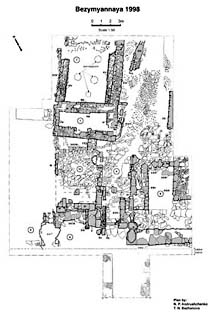
View of the excavation at Bezymyannaya from the south at the close of the 1998 excavation season. In the right foreground are Rooms 7 and 2. The floor associated with the interior walls has been removed, exposing a surface composed of fallen tiles and charred material. A coin of Constantius II (337-361 AD) was found here, which serves to date this surface to a period not earlier than the first half of the fourth century AD.
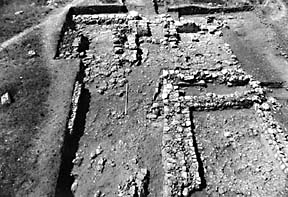
A total of twelve coins were recovered during the 1998 campaign at Bezymyannaya, bringing the total from the site now to twenty. Among this year's finds were one of Constantine I (307-337 AD), one of Valentinian I (364-375 AD), one of the mint of Rome with a portrait of Floxillus (379-386 AD), one of Leo I (474-491), two of Justinus (474-491 AD), and one of Justinian I (527-545 AD). Two coins of Mithridates VI Eupator (120-63 BC) issued at Amisos, document the late Hellenistic period, when Chersonesos was under the protection of the Pontic ruler.
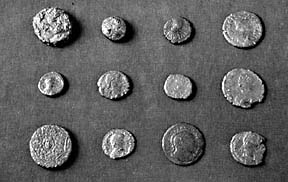
Also uncovered from the site were several bullets and mortar shells dating from the Crimean War and World War II.

The excavation of Bezymyannaya is visible in this IRS (Indian Remote Sensing) satellite image taken in October 1997. Also visible is the encroaching sprawl of urban development.
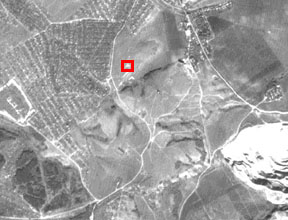
This view of the hilltop site at Bezymyannaya, taken from a helicopter in July 1998, clearly reveals the general topographical features of the fort. The fossa (moat) and vallum (rampart) are now generally thought to belong to the period of the Crimean War. There is a possibility that it may have originated in the early Byzantine period.
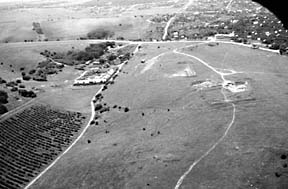
The 1998 University of Texas team at Chersonesos. Front row (left to right): Paul Lehman, Mindy Spearman, Jessica Trelogan; middle row: Olenka Pevny, Jane Rempel, Maya Milanytch, Jason Lucas; back row: Joseph Carter (Director), Phil Freeman (Field Director), Bronwen Wickkiser, Sophia Petrovich.
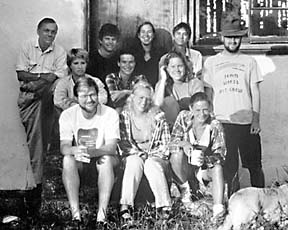
Back to Bezymyannaya

Last Modified: Wed Apr 14, 1999
CSR/TSGC Team Web
|

